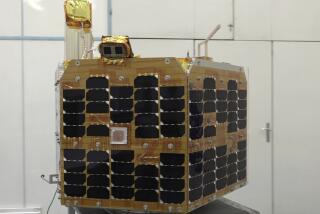U.S. Probe Goes Aloft on Soviet Rocket : Space: It’s the first big joint project since 1975’s Apollo-Soyuz linkup. The instrument will monitor Earth’s ozone layer.
- Share via
MOSCOW — From a birch forest in northern Russia, a rocket roared skyward Thursday carrying a U.S.-built instrument to monitor the Earth’s ozone layer, thus launching the biggest joint superpower space project since the 1975 Apollo-Soyuz linkup.
State-run Soviet television happily called the launch a marriage of the brawn of Soviet rocketry and the precision of American high technology, and Radio Moscow said more spectacular things might be in store.
About as big as a shoe box and weighing about 60 pounds, the U.S. device, known as TOMS (for Total Ozone Mapping Spectrometer), is designed to monitor a large hole in the ozone layer that usually appears over Antarctica from late August until mid-November.
TOMS was launched aboard a Soviet-made Cyclone rocket shortly after noon from the Plesetsk Cosmodrome, a once top-secret military rocket base located in dense woods 600 miles north of Moscow. The U.S.-built gadget, piggybacking on a Soviet Meteor-3 weather satellite, went into an orbit about 750 miles up, the official news agency Tass reported.
According to the National Aeronautics and Space Administration, TOMS is the first U.S. instrument placed aboard a Soviet satellite, and the mission to launch it was at least two years in the making. Another of the spectrometers has been mapping global ozone layers from an orbiting American satellite, the Nimbus-7, since 1978.
The new mission will try to gauge how much of the damage to the Earth’s ozone layer--which shields the planet from harmful ultraviolet rays--is due to man-made chemicals, such as chlorofluorocarbon propellants in aerosols, and what can be attributed to natural causes.
Both U.S. and Soviet scientists will share data from the satellite, which is expected to remain aloft for at least two years. Once every two weeks, controllers at NASA’s Goddard Space Center in Greenbelt, Md., will transmit orders to TOMS to control its operations.
It was on July 17, 1975, that three American astronauts in an orbiting Apollo capsule linked up with two cosmonauts in their Soyuz spacecraft. Although many thought large-scale superpower cooperation in space to be inevitable, given the challenges and the costs, the Apollo-Soyuz flight turned out to be a one-shot deal.
Nonetheless, the joint manned mission laid the groundwork for U.S.-Soviet contacts about space affairs and established good relations between NASA and Soviet space officials. And now, with the climate between Moscow and Washington sunnier than ever, the superpowers are talking about ways to cooperate in space.
At the July summit in Moscow, the two agreed to accelerate cooperation in space. Radio Moscow said Thursday that, according to the terms of the accord, by 1993 a Soviet cosmonaut may take part in a U.S. space shuttle flight and an American astronaut may join a Soviet crew aboard the Mir space station.
More to Read
Sign up for Essential California
The most important California stories and recommendations in your inbox every morning.
You may occasionally receive promotional content from the Los Angeles Times.













